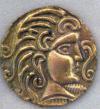Tree-Bark Thickness Indicates Fire-Resistance in a Hotter Future

A new study has found that trees worldwide develop thicker bark when they live in fire-prone areas. The findings suggest that bark thickness could help predict which forests and savannas will survive a warmer climate in which wildfires are expected to increase in frequency.
Trees in regions where fire is common, such as savannas and the forests of western North America, tend to have thicker bark, while trees in tropical rainforests have thinner bark, researchers at Princeton University and collaborating institutions reported Jan. 9 in the journal Ecology Letters. Bark protects the inside of the trunk from overheating and is one of a handful of adaptations that trees use to survive fire.
“We found large-scale evidence that bark thickness is a fire-tolerance trait, and we showed this is the case not just in a particular biome such as a savanna, but across different types of forests, across regions and across continents,” said first author Adam Pellegrini, a NOAA Climate and Global Change Postdoctoral Fellow at Stanford University who led the study while a graduate student in Princeton’s Department of Ecology and Evolutionary Biology.Researchers at Princeton and collaborating institutions found that bark thickness in tree species across the globe was greater in ecosystems with higher incidence of fire.
The figure shows that tree bark grows thicker (red) in areas with savannas, which tend to burn every two to five years, and thinner (blue) in less frequently burned ecosystems, such as tropical rainforests. Trees in forests in the lower half of North America, which experience periodic fires, have middle to thick amounts of bark.
Image courtesy of John Wiley & Sons
Pellegrini and his colleagues looked at 572 tree species in regions across the globe. They compared bark thickness from trees in areas that experience frequent wildfires — and where rain falls only seasonally — to trees in regions where fires are rare, such as tropical rainforests. They found that in areas where fires are frequent, most trees, no matter the species, have thicker bark than closely related tree species growing in low-fire areas.
The study suggests that tropical rainforests — which are mostly composed of thin-barked trees — may have a more difficult time recovering from fire, whereas savannas and seasonal forests with thickly barked trees should be able to better withstand fire. A savanna was defined as land with continuous grass cover that is 20 to 80 percent trees, while a forest was defined as having complete tree coverage and little to no grass.
Bark of a tree species found in the Brazilian Cerrado, which can burn every 3-7 years and contains some of the thickest barked species in the world, with Connarus suberosus having 30 percent of its stem diameter consisting of bark.
Photo courtesy of Adam Pellegrini
The researchers also addressed the question of where thick-barked trees come from: Did they evolve to have thick bark in response to living in a fire-prone region, or do thick-barked trees come from plant families with species that all tended to develop thick bark irrespective of fire activity?
To find out, the researchers compared related tree species that live in fire-prone areas against those that are found in non-fire-prone regions. The researchers found that the bark thickness of closely related species is linked to whether the species lived in a fire-prone or non-fire-prone region, which provided further evidence that bark thickness is an evolutionary adaptation to fire.
Tim Coulson, a professor of zoology at Oxford University, said that the study illustrates how climate change could create conditions that already-endangered ecosystems cannot withstand.
“As periods of drought begin to be seen more frequently in tropical forests — the lungs of our planet — the risk that these ecosystems will burn increases,” said Coulson, who is familiar with the study but had no role in it.
“Because the species found there are not well-adapted to cope with fire, the consequences could be devastating,” he said. “[This] work highlights that the changes we are making to our climate can put ecosystems at risk to factors, such as fire, that they are poorly equipped to deal with.”
Contacts and sources:
Catherine Zandonella
Princeton University
Source: http://www.ineffableisland.com/2017/01/tree-bark-thickness-indicates-fire.html
Anyone can join.
Anyone can contribute.
Anyone can become informed about their world.
"United We Stand" Click Here To Create Your Personal Citizen Journalist Account Today, Be Sure To Invite Your Friends.
Please Help Support BeforeitsNews by trying our Natural Health Products below!
Order by Phone at 888-809-8385 or online at https://mitocopper.com M - F 9am to 5pm EST
Order by Phone at 866-388-7003 or online at https://www.herbanomic.com M - F 9am to 5pm EST
Order by Phone at 866-388-7003 or online at https://www.herbanomics.com M - F 9am to 5pm EST
Humic & Fulvic Trace Minerals Complex - Nature's most important supplement! Vivid Dreams again!
HNEX HydroNano EXtracellular Water - Improve immune system health and reduce inflammation.
Ultimate Clinical Potency Curcumin - Natural pain relief, reduce inflammation and so much more.
MitoCopper - Bioavailable Copper destroys pathogens and gives you more energy. (See Blood Video)
Oxy Powder - Natural Colon Cleanser! Cleans out toxic buildup with oxygen!
Nascent Iodine - Promotes detoxification, mental focus and thyroid health.
Smart Meter Cover - Reduces Smart Meter radiation by 96%! (See Video).





